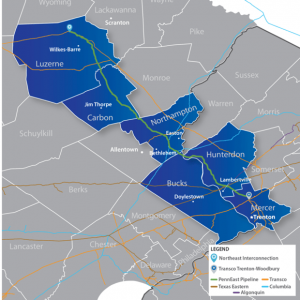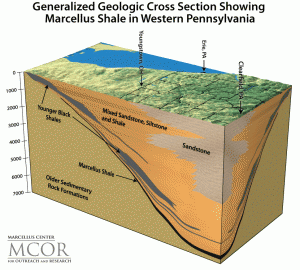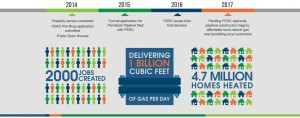Introduction
[Please find the pdf version of this entire web-based report here.]
What can we do to help local citizens understand the implications of a newly proposed natural gas pipeline in Northampton County?
We might be on the brink of the next “gold rush”. Instead of gold, it is natural gas. Americans won’t be rushing out West to find this “gold” they will be rushing to the Marcellus Shale. The Marcellus Shale is home to an abundant amount of natural gas. We are a nation that is dependent on oil and natural gas to power energy in this country. Together, oil and natural gas account for half of society’s primary energy supply (Carlyle, 2013, p.30 ). Therefore it should be no surprise that if natural gas pipelines, from the United States alone, were stretched out they could travel from the Earth to Moon seven to eight times (Carlyle, 2013, p.30). With the continuing rise in demand for natural gas, companies in this industry are quickly trying to grab a stake of the Marcellus Shale. PennEast pipeline Company (PennEast) is one of those companies. PennEast has proposed to run a 108-mile length, 36-inch diameter, natural gas gathering pipeline from Wilkes-Barre, Pennsylvania to Trenton, New Jersey. This capstone project for the Engineering Studies program is by Kaitlyn Koch, John Paul Bisciotti, and Daniel Kaufmann. We are members of the Engineering Studies Class of 2015 at Lafayette College. As a part of our capstone project we were devised the research question “what can we do to help local citizens understand the impacts of a pipeline running through Northampton County?” To answer this question we have composed an informative website to help the residents of Northampton County understand the implication and consequences of this pipeline running through their residencies. Our website can be found at https://sites.lafayette.edu/pipelinepolitics/.

In order to fully understand what a natural gas gathering transmission means to the residents of Northampton County, an explanation is needed for the contexts and analysis of what this proposed pipeline means from start to finish. PennEast Company has proposed to construct a natural gas pipeline in Wilkes-Barre, Pennsylvania. Wilkes-Barre is located in the Northeast area of Pennsylvania, and also located in the Marcellus Shale. Found in the Allegheny Plateau, the Marcellus Shale is a geological formation that holds a vast amount of natural gas (Pritchard, 2013, p.1). The natural gas found in the Marcellus Shale can only be accessed by hydraulic fracturing. Those who support the fracturing of the shale say that the amount of natural gas located in the shale can help the United States reduce its dependence on foreign gas. It is estimated the Marcellus Shale contains between 50 trillion to 500 trillion cubic feet of natural gas (Barnhart, 2014, p. 1). In 2013, the United States consumed about 26 trillion cubic feet of natural gas (Energy Information Administration, 2014). The greatest argument for hydraulic fracturing is that it will bring substantial economic development for the Pennsylvania section of the Marcellus Shale. It is contended the extraction of natural gas in Pennsylvania will bring much-needed revenues to the state, jobs to the community and revenues from leasing to struggling landowners. (Pritchard, 2013, p.1)

The Marcellus Shale is the reason why PennEast is proposing their pipeline to begin in Wilkes-Barre. Hydraulic fracturing will extract natural gas from the Wilkes-Barre area, the natural gas will then be transported through the pipeline to Trenton, New Jersey. The pipeline is the component of this proposal that will affect Northampton County residents the most. Due to the geographical location of Northampton County, the pipeline will run directly through the county in order to reach its final destination in New Jersey. According to the Pipeline and Hazardous Materials Safety Administration (PHMSA) *gathering pipeline are intended to ”transport gases and liquids from the commodity’s source-like rock formations located far below the drilling site- to a processing facility refinery or a transmission line.” PHMSA stands by that pipelines are still the safest means of transporting hazardous liquids and natural gas. Pipelines are regulated by all of the following or individually either by the government and states and also the PHMSA.
Due to Northampton County falling right in the middle of this transmission pipeline proposal route, the short term future entails residents having grant permission to PennEast Company survey their land. They will have to negotiate with PennEast over land rights. After permitting and surveying is completed the construction of the pipeline then may begin. In the long term future, residents of Northampton County will have to accept having the pipeline in their land. But they will also have to accept the consequences of the pipeline in their community, the United States and internationally. Understanding the social, policy, economic and technical context and analyses behind the proposal by PennEast for the transmission pipeline, via the website, will allow the residents to form their own educated opinion and understanding of the pipeline.

The social context behind the pipeline proposal is best explained by the history of energy production in Pennsylvania and the environmental implication of the pipeline. Going back to 1859, Pennsylvania became home to the first oil-drilled well. In 1957 Pennsylvania became home to the nation’s first commercial nuclear reactor. Pennsylvania is also a major coal producer, and has provided the nation with energy for many decades. Today, the Marcellus Shale is setting Pennsylvania up to be a major supplier of natural gas to the nation. Over time, coal production became known for, not only the horrible working conditions in the mines, but also the environmental consequences. The Atlantic Sunrise Expansion project, a natural gas pipeline cutting through Pennsylvania, is a year ahead of PennEast and is causing disapproval from residents, especially in Lancaster, PA. If residents of Pennsylvania understand the history of energy production and its consequences, although they have supported energy production in the past, they may help them form an opinion on what type support they want to give to projects like this to shape the future of Pennsylvania.
The economic analysis of the proposal by PennEast has three key stakeholders. These stakeholders are PennEast , FERC, and property owners. For the PennEast their economic cost will entail construction cost, which is approximately $1 billion per a project and also the included cost of jobs. The cost of jobs will entail about 2000 workers for about seven months to a year. The consumers are the residents of New Jersey. The end location for this pipeline is Trenton, NJ. The price for consumers of natural gas in New Jersey will have prices drop from $100 per dekatherm to $4 per dekatherm. For property owners, a long term benefit will be that property taxes will be paid during ongoing constriction of the pipeline. For example the municipal landowners in Hunterdon County are expected to earn tax revenue of $6.8 million over 5 years. In a larger context of this analysis there are also implications for a new surge in the amount of natural gas being produced for/by the United States in terms of the GDP and total energy production.
The technical analysis PennEast’s pipeline proposal must consider including, pipe grade, material, thickness, and more. The temperature and pressure of the natural gas transported through the pipeline are also important factors that determine the pipeline’s efficiency and safety. The pipeline could experience a number of technical problems such as natural gas emissions, leakages, and ruptures that could have terrible consequences on public safety and the environment. Another aspect of the technical aspect must be the informative website. Included on the website will be fact sheets which are another component in the technical analysis.Consideration of how the layout will be for the website must be investigated under the technical analysis.
The policy analysis includes determining who, where and what behind this proposal. The supporters of the PennEast pipeline proposal include AGL Resources, NJR Pipeline Company, South Jersey Industries, UGI Energy Services (UGIES), and Public Service Enterprise Group. They support this proposal because of profit from lower natural gas prices for New Jersey and potentially Pennsylvania customers. The Federal Energy Regulatory Commission (FERC) is who has control over the entire PennEast proposal. Without their approval this whole project could be stopped. Another “who” in this project are the residents, property owners, environmentalist, and Federal Energy Regulatory Commission. The Federal Energy Regulatory Commission is who has control over the entire PennEast proposal. Without their approval this whole project could be stopped. Residents play a key role with public health and environmental health. Environmentalist will also have key role with environmental health. Property owners will have a key role with eminent domain, public health and environmental health. The “what” of this process is solving how can problems from the “who” be resolved. Often these answers will be found through education from public organizations and also legal rules.
The social context and the economic, technical and policy analysis of the PennEast Company proposal for the natural gas gathering pipeline will provide critical information for the website. Each of these sections will be used to help structure this website into an informative well developed website and fact sheets.
The bibliography for “Pipeline Politics” can be found under “Bibliography“.
